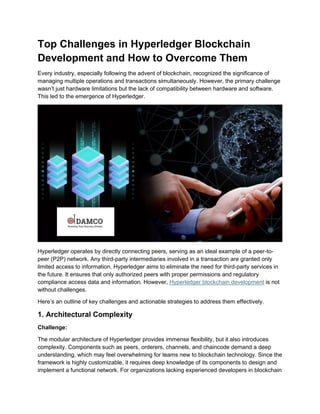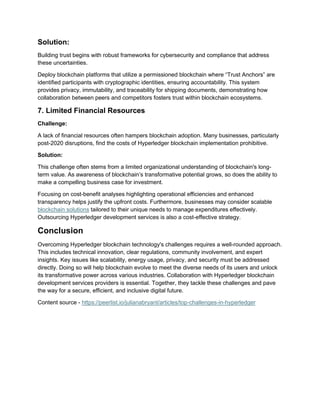Understanding Challenges in Hyperledger Blockchain Development
- 1. Top Challenges in Hyperledger Blockchain Development and How to Overcome Them Every industry, especially following the advent of blockchain, recognized the significance of managing multiple operations and transactions simultaneously. However, the primary challenge wasn’t just hardware limitations but the lack of compatibility between hardware and software. This led to the emergence of Hyperledger. Hyperledger operates by directly connecting peers, serving as an ideal example of a peer-to- peer (P2P) network. Any third-party intermediaries involved in a transaction are granted only limited access to information. Hyperledger aims to eliminate the need for third-party services in the future. It ensures that only authorized peers with proper permissions and regulatory compliance access data and information. However, Hyperledger blockchain development is not without challenges. Here’s an outline of key challenges and actionable strategies to address them effectively. 1. Architectural Complexity Challenge: The modular architecture of Hyperledger provides immense flexibility, but it also introduces complexity. Components such as peers, orderers, channels, and chaincode demand a deep understanding, which may feel overwhelming for teams new to blockchain technology. Since the framework is highly customizable, it requires deep knowledge of its components to design and implement a functional network. For organizations lacking experienced developers in blockchain
- 2. technology, this steep learning curve delays the deployment process. It also increases development costs. Solution: Invest in team training and education to build foundational knowledge of Hyperledger components. Utilize official documentation, tutorials, and online resources. A Hyperledger blockchain development company provides expert guidance to streamline architecture design and deployment, reducing the learning curve for in-house teams. 2. System Integration Challenge: A significant obstacle in Hyperledger development is integrating blockchain technology with existing legacy systems. Businesses often have complex infrastructure built on traditional databases. In many cases, existing systems were not designed with blockchain in mind. This makes the integration process particularly challenging. Solution: A strategic approach to integration significantly reduces the friction of adopting Hyperledger. It is crucial to establish clear integration requirements. Ensuring that communication protocols between systems are well-defined is essential. Middleware or adapter layers help bridge the gap between blockchain and legacy systems. Comprehensive testing is also necessary to ensure that the systems communicate effectively and efficiently. Here’s what you can do: • Focus on interoperability during the design phase. • Use middleware solutions or API bridges to connect the blockchain network with existing infrastructure. • Collaborate with Hyperledger blockchain development services providers to design adaptable interfaces and communication protocols. • Test rigorously to ensure compatibility and smooth data flow across systems. 3. Performance and Scalability Challenge: As transaction volumes grow, performance and scalability become important considerations in Hyperledger blockchain development. While Hyperledger is designed for enterprise use, it still faces challenges when handling large amounts of data. Hyperledger Fabric, for instance, is designed for high performance. However, as the transaction volume increases, the system may slow down, affecting overall efficiency. Hyperledger relies on consensus mechanisms such as the "endorsement policy." This requires multiple peers to validate transactions. As the network grows, this process results in bottlenecks, hindering the speed of transaction processing. Solution:
- 3. Several measures help optimize performance. Partner with a Hyperledger development company that fine-tunes network configurations and allocates resources efficiently. Optimizing consensus mechanisms is another strategy. Load balancing and parallel transaction processing help improve scalability in Hyperledger networks. Additionally, adopting off-chain solutions eases the burden on the blockchain network, improving overall performance. 4. Identity and Access Management Challenge: Managing identities and controlling access in a permissioned blockchain environment, such as Hyperledger, is intricate. Ensuring only authorized entities access and transact within the network is vital for maintaining security and compliance. Solution: Use robust identity management solutions, including certificate authorities (CAs) and identity providers (IdPs), to authenticate participants. Define role-based access controls to regulate permissions effectively. Regular audits of access privileges ensure alignment with organizational needs. Advanced security measures like multi-factor authentication or zero- knowledge proofs further strengthen the network. 5. Regulatory Compliance Challenge: Hyperledger blockchain development solutions must adhere to industry-specific regulations like data privacy, financial laws, and regional legal standards. Navigating these regulatory frameworks is complex, especially for industries like finance and healthcare. Solution: Conduct a detailed regulatory analysis during the initial stages of the project. Design the solution with compliance in mind, including features like encryption, detailed audit trails, and data residency controls. Collaborate with legal experts and regulatory advisors to align the blockchain implementation with applicable laws. Partnering with a Hyperledger blockchain development company helps ensure your solution remains compliant as regulations evolve.6. 6. Lack of Trust Among Participants Challenge: Some businesses lack confidence in the security of blockchain technology itself, while others may not trust the participants within a blockchain network. The absence of centralized oversight compounds this issue, as the Hyperledger blockchain relies on decentralized verification mechanisms. Regulatory ambiguities and hesitancy about interoperability between business networks further contribute to the trust deficit.
- 4. Solution: Building trust begins with robust frameworks for cybersecurity and compliance that address these uncertainties. Deploy blockchain platforms that utilize a permissioned blockchain where “Trust Anchors” are identified participants with cryptographic identities, ensuring accountability. This system provides privacy, immutability, and traceability for shipping documents, demonstrating how collaboration between peers and competitors fosters trust within blockchain ecosystems. 7. Limited Financial Resources Challenge: A lack of financial resources often hampers blockchain adoption. Many businesses, particularly post-2020 disruptions, find the costs of Hyperledger blockchain implementation prohibitive. Solution: This challenge often stems from a limited organizational understanding of blockchain's long- term value. As awareness of blockchain’s transformative potential grows, so does the ability to make a compelling business case for investment. Focusing on cost-benefit analyses highlighting operational efficiencies and enhanced transparency helps justify the upfront costs. Furthermore, businesses may consider scalable blockchain solutions tailored to their unique needs to manage expenditures effectively. Outsourcing Hyperledger development services is also a cost-effective strategy. Conclusion Overcoming Hyperledger blockchain technology's challenges requires a well-rounded approach. This includes technical innovation, clear regulations, community involvement, and expert insights. Key issues like scalability, energy usage, privacy, and security must be addressed directly. Doing so will help blockchain evolve to meet the diverse needs of its users and unlock its transformative power across various industries. Collaboration with Hyperledger blockchain development services providers is essential. Together, they tackle these challenges and pave the way for a secure, efficient, and inclusive digital future. Content source - https://peerlist.io/julianabryant/articles/top-challenges-in-hyperledger




